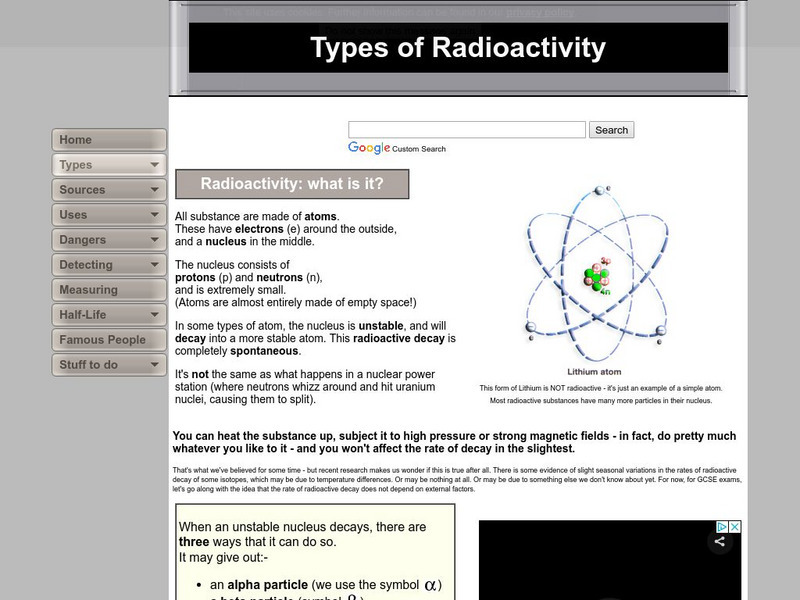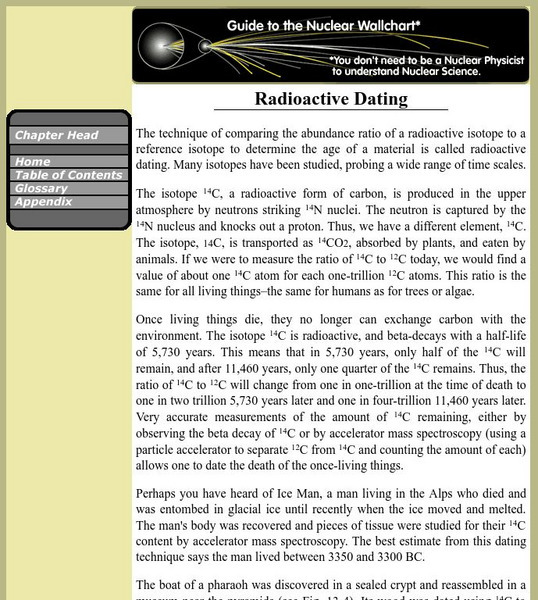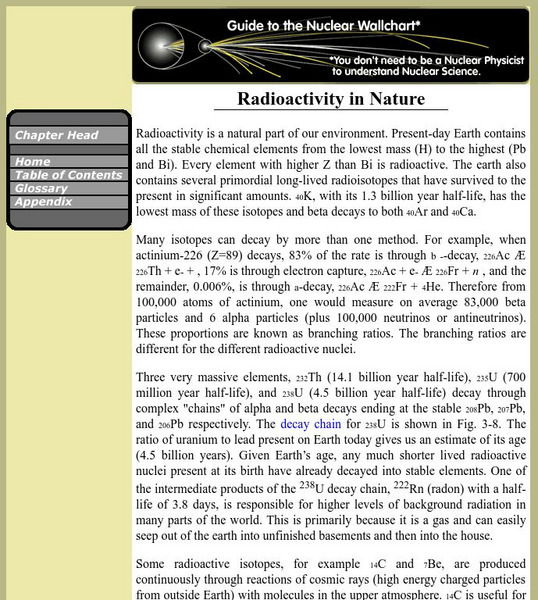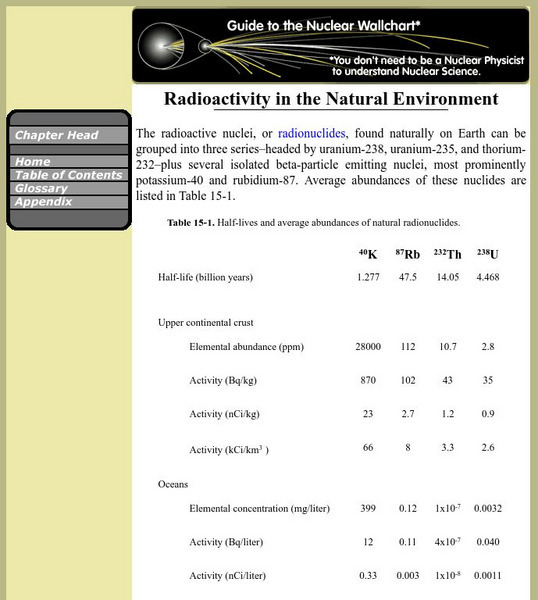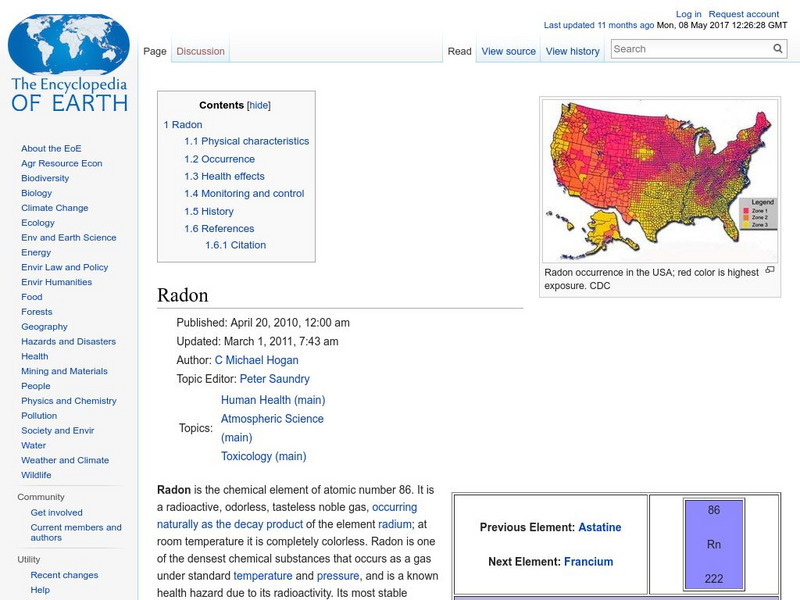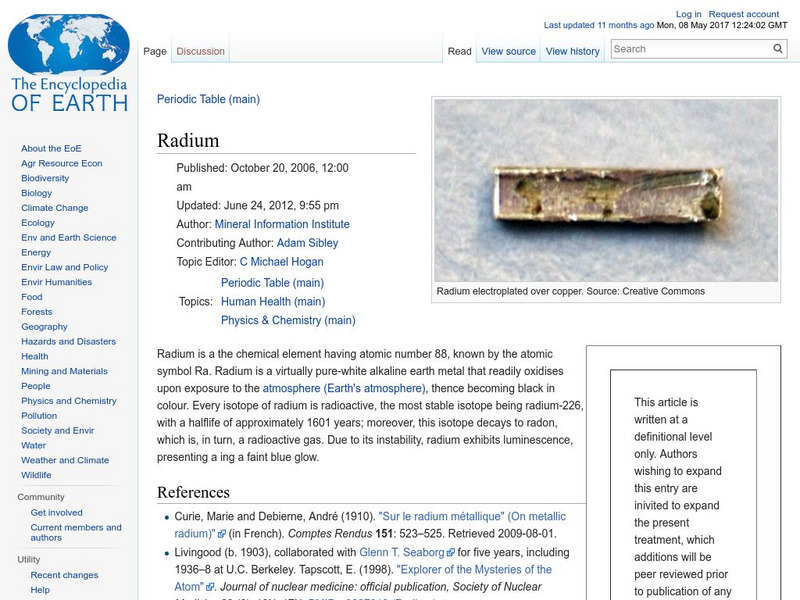National Institute of Open Schooling
Radioactive Pollution
Radioactive pollutants can enter the body through ingestion, inhalation, absorption, or injection. The last lesson in a series of 36 introduces pupils to radioactive pollution. They study its sources, both natural and man-made, its...
Jefferson Lab
The Periodic Table of Elements
A study of the periodic table of elements doesn't have to be elementary! Deepen understanding of the building blocks of chemistry with an interactive periodic table. At first sight, the table looks like a standard reference page, but a...
American Chemical Society
Joseph Priestley, Discoverer of Oxygen
Do you want to hear a joke about nitrogen and oxygen? NO. We all know there is oxygen in the air and that plants produce oxygen, but how was it discovered? Scholars read a handout, answer questions, and analyze material in the...
Australian Museum
Australian Museum: Radioactive Dating
This article explains what radioactive dating is and describes the different techniques used, what they are used for, and the limitations of each.
Science Struck
Science Struck: List of Radioactive Elements
Learn about radioactivity, the different types of radioactive decay, isotopes, and half-life of a radioactive element. Includes a long chart listing radioactive elements, atomic number and mass number, decay type, and length of half-life.
Science Struck
Science Struck: How Does Radioactive Decay Work?
Explains the processes of radioactive decay in primary and secondary modes.
University of Michigan
University of Michigan: Radioactivity in Nature
An interesting essay about the prevalence of radioactivity in nature, with chart showing where it is found and information about half lives.
Science Struck
Science Struck: Radioactive Isotopes in Medicine
Learn what radioactive isotopes are and the different ways that they are used in medicine.
Upper Canada District School Board
Tom Stretton's Chemistry Pages: Radioactivity
Deepen your understanding of radioactivity. Find out about the history and chemistry behind the concept.
Other
Andy Darvill's Science Site: Types of Radioactivity
Find out about radioactivity, and how it occurs inside an atom's unstable nucleus.
Math Medics
S.o.s. Math: Exponential and Logarithmic Functions /Radioactive Decay
A set of examples and exercises that show how to solve radioactive decay problems by using exponents and logarithms.
Science Museum, London
Science Museum: Online Stuff: Marie Curie and the History of Radioactivity
Read about Nobel Prize winner, Marie Curie's life, and her historical work with radioactivity.
Lawrence Berkeley National Laboratory
Berkeley Lab: Radioactivity
Overview of radioactivity, the process in which particles are emitted from nuclei as a result of nuclear instability.
Lawrence Berkeley National Laboratory
Berkeley Lab: Radioactive Dating
This site provides an overview of radioactive dating, a process used to determine the age of rocks and other materials.
CK-12 Foundation
Ck 12: Earth Science: Radioactive Decay as a Measure of Age Study Guide
[Free Registration/Login may be required to access all resource tools.] Summarizes the key points about how radioactive particles decay. Includes a few questions to check for understanding.
Lawrence Berkeley National Laboratory
Berkeley Lab: The Discovery of Radioactivity
Features an overview of the discovery of radioactivity by Henri Becquerel in 1896.
Lawrence Berkeley National Laboratory
Berkeley Lab: Radioactivity in Nature
This entry provides a summary of radioactivity in nature and the decay chain.
Lawrence Berkeley National Laboratory
Berkeley Lab: Radioactivity in the Natural Environment
Charts take a look at radioactive nuclei found naturally on Earth.
Lawrence Berkeley National Laboratory
Berkeley Lab: Units of Radioactivity
Provided is a brief explanation of the units of radioactivity and how they are measured.
Lawrence Berkeley National Laboratory
Berkeley Lab: Units of Radioactivity and Dose
Learn about the units for measuring the amount of radioactivity and the categories of radiation dose.
Chem4kids
Chem4 Kids: Atoms: Neutrons
Students will find an explanation of the neutron particle located inside the atom's nucleus. Website also defines isotopes and the process of radioactive decay.
Encyclopedia of Earth
Encyclopedia of Earth: Uranium
Information about the radioactive element, Uranium, atomic number 92. Describes its history, physical and atomic properties, how abundant it is on the Earth, and permissible exposure limits. Also discusses sources, uses, isotopes,...
Encyclopedia of Earth
Encyclopedia of Earth: Radon
Information about the radioactive element, Radon, atomic number 86. Covers physical properties, atomic properties, how abundant it is on the Earth, details about its impact on human health, and about how it can be monitored.
Encyclopedia of Earth
Encyclopedia of Earth: Radium
Information about the radioactive element, Radium, atomic number 88. Covers physical and atomic properties, how abundant it is on the Earth, and permissible exposure limits.
Other popular searches
- Radioactivity Half Life
- Radioactivity Decay
- Nucleus Radioactivity
- Nuclear Radioactivity
- Radioactivity Lab
- Radiation and Radioactivity
- Radon and Radioactivity
- Environmental Radioactivity
- Analogy Radioactivity
- Radioactivity Disintegration
- Marie Curie Radioactivity
- "Radioactivity" Chemistry






